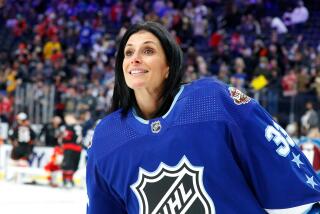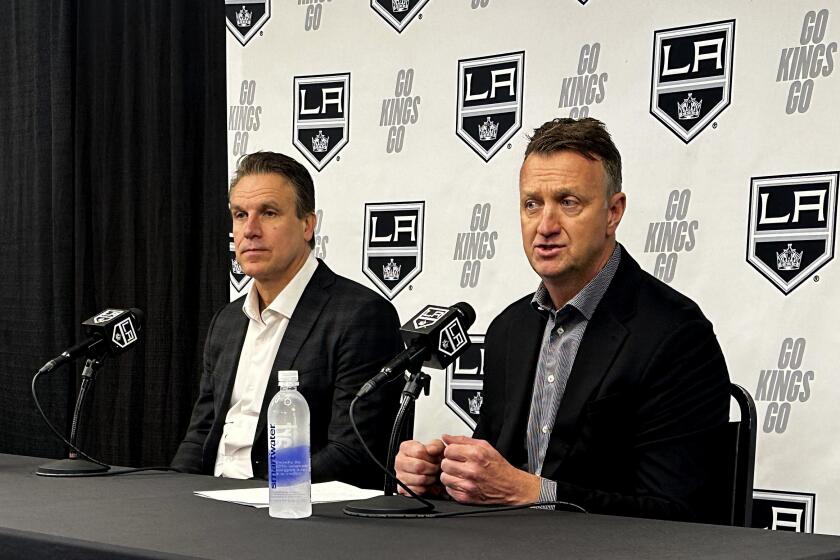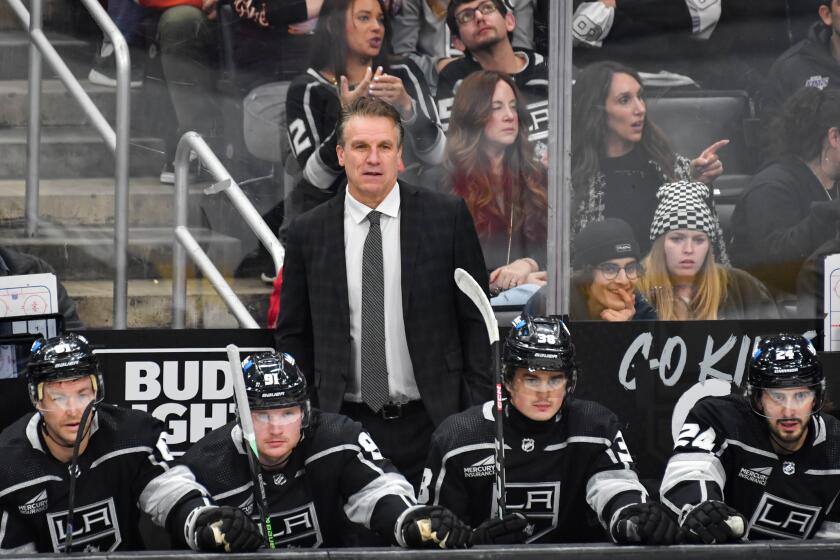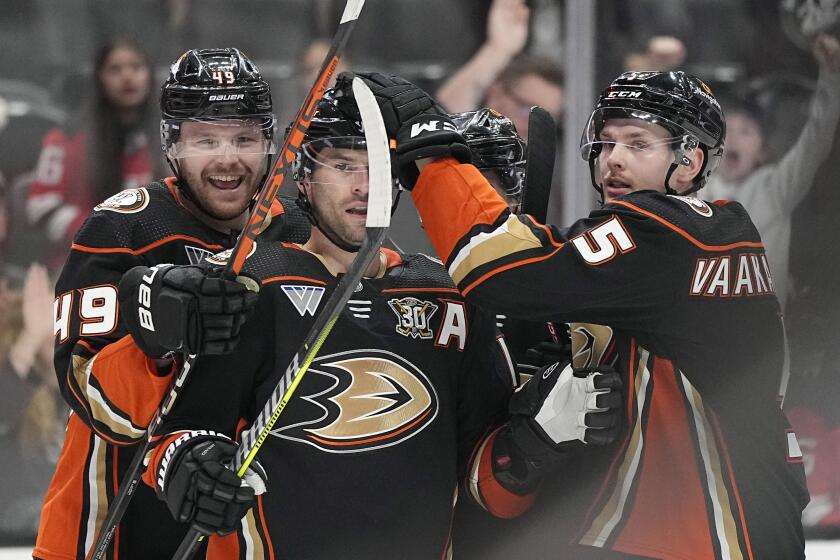The Art of Hockey Is Back
Sidney Crosby darts left, cuts back right through the huge offensive zone, and is still going as he gets within stick length of the goalie, who has no idea which way the rookie will shift next.
Back in the day, he’d have a stick in his ribs and an opponent’s arm pulling him from behind.
Not anymore.
Defensemen have a choice: Let him go in alone, or hold him up and spend two minutes in the penalty box. Obstruction is gone from the new NHL, and the art of hockey is back on the ice.
“Whatever they learned all their life goes straight out the window,” New Jersey goalie Martin Brodeur said. “You can’t do the pin and hold, you can’t do the old can opener, you can’t do anything anymore. It’s definitely hard for the D, especially if mobility is not one of your assets.”
The big, burly defenseman still has a role in the game, but his effectiveness has been severely compromised in this new world of free-flowing hockey. Not only can’t he hold up an onrushing forward, he can’t clear players out from in front of the net, either.
It is here that most power-play goals are scored on deflections and rebounds. And with the increase in penalties being called because of the new zero-tolerance policy on obstruction, players such as 5-foot-10 New York Rangers rookie Petr Prucha have more opportunities to charge in without fear of getting clobbered.
“He’s a small guy and he always looks for the open spot in front,” teammate Martin Straka said of Prucha, who scored half his first 12 goals on the power play. “He’s getting all the rebounds, so he is not afraid at all.”
The NHL knew it had to pull out every stop to win back fans and make new ones following last season’s hiatus caused by the worst labor dispute in North American sports history.
Sure, cheaper tickets and clever promotions help, but if people aren’t interested in the product to begin with, it’s hard to get them through the turnstiles.
As baseball has found, fans dig offense. And that’s where hockey has a unique advantage.
Mammoth blasts off the bats of sluggers are impressive, but the only thing that distinguishes a shot by Barry Bonds from one by Alex Rodriguez is what row the ball lands in and which side of the plate they swing from.
Not so on the ice.
“The great players have tremendous creativity. They see things in a certain way, they create things. This is the ultimate read-and-react sport,” said San Jose general manager Doug Wilson, a former defenseman who posted 827 career points.
Goals can be scored by a player ripping a 100-mph slap shot past an overmatched goalie or by someone who reaps the benefits of a threaded pass from a teammate. It’s not always the goal scorer who does the heavy lifting.
“I think guys are having more of an opportunity to use their creativity now because when you’re skating by a guy they can’t get their stick on you,” Minnesota Wild center Brian Rolston said. “They’ve got to try to poke it, and guys that have better hands can keep it away from those pokechecks.
“There’s no question that the game has opened up and it’s made it a lot easier for skill guys to do what they have to do.”
At 18, Crosby already is considered a master playmaker. His vision is superb and he also has the moves to elude defenders trying to separate him from the puck.
Sometimes he sets himself up, but other times he moves goalies so far out of position that when he makes a pass across the crease, a teammate merely has to redirect the puck into an open side of the net.
“The things you’re looking for in players is hockey sense, and that means seeing something, reacting quickly and creating something out of sometimes when there’s nothing,” Wilson said. “That’s very artistic, very creative.”
“Some guys have got it and some guys have it more than others,” Rolston said.
But that part of the game was lost in the previous decade or so. The neutral-zone trap became the norm once current Wild coach Jacques Lemaire led the New Jersey Devils to the 1995 Stanley Cup championship.
The trap led to the clutching and grabbing that made end-to-end rushes uncommon. Goal scoring became as tough as pulling teeth.
“What we traditionally let go in terms of the one or two hooks on the arm, which would be historically considered as a good play, is now an unacceptable practice in the game,” NHL director of officiating Stephen Walkom said.
Lemaire remembers the little hooks and pulls of the stick back when he was scoring goals and winning eight Stanley Cups with the Montreal Canadiens between 1967-79.
Even those little tugs probably wouldn’t fly in this no-obstruction world. Lemaire might’ve played in the golden age of hockey, but he says the game he coaches now is even better.
“I don’t know that we’re getting back, I think we’re giving players a chance to show what they have,” said Lemaire, who scored 366 goals and set up 469 others. “I think right now is the best hockey we could get.”
Lemaire is still coaching the trap, but now he is back in the minority.
With two-line passes now legal since the red line no longer exists for the purposes of making plays offsides, it is hard to pin teams in their own zones. It’s even more difficult with the enforcement of the rules.
“I don’t think the excellence was rewarded,” Wilson said of the pre-obstruction days. “I think it rewarded those that were trying to drag it down.
“You should reward excellence, punish cheating and don’t cater to mediocrity. Make people get better both offensively and defensively.”
He can speak from experience. Wilson played during the offensive explosion of the 1980s, when Wayne Gretzky had four 200-point seasons and Mario Lemieux had 199 points in a season.
This season, the Ottawa Senators scored 115 goals in their first 25 games to put themselves in shooting range of becoming the first club since the 1985-86 Edmonton Oilers to have 400 in a season. That Gretzky-led squad scored 426.
And the quick starts by Senators captain Daniel Alfredsson, Philadelphia’s Simon Gagne and the New York Rangers’ Jaromir Jagr have hockey people buzzing about the possibility of a 50-goal scorer in 50 games.
“I think you’ll see over time, teams will be able to manufacture some really good things offensively,” Rangers coach Tom Renney said. “I think the best is yet to come.”
More to Read
Go beyond the scoreboard
Get the latest on L.A.'s teams in the daily Sports Report newsletter.
You may occasionally receive promotional content from the Los Angeles Times.




